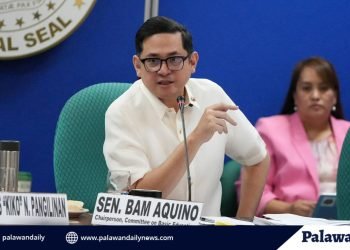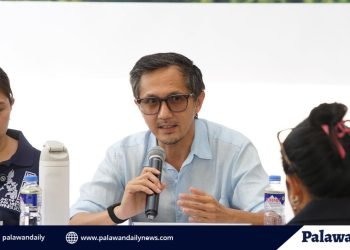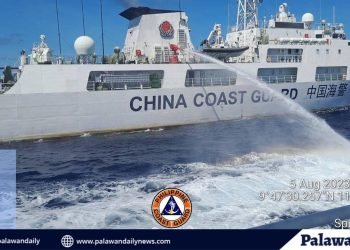Nine years after the Philippines scored a landmark legal victory at the Hague-based Permanent Court of Arbitration, the country is taking firmer steps to assert its presence in the West Philippine Sea (WPS), starting with long-term military and infrastructure expansion on Pag-asa Island, the seat of Kalayaan municipality in the disputed Spratly group.
Vice Admiral Alfonso Torres Jr., commander of the Western Command (Wescom), confirmed during the July 12 commemoration of West Philippine Sea Victory Day that the government is intensifying its presence in the region, both militarily and through partnerships with civilian communities.
“Expect more and better infrastructure projects,” Torres said in his address during the celebration held at Wescom headquarters in Puerto Princesa. “These projects will strengthen and fortify our occupation in all our islands.”
Pag-asa, located about 480 kilometers west of Palawan’s mainland, is the largest Philippine-occupied feature in the Spratlys and is home to nearly 200 Filipino civilians. Though relatively isolated, it holds immense strategic value for the country’s maritime and territorial claims.
Military Footprint Expands
While Pag-asa Island has seen key developments in recent years, including the improvement of its airstrip, the installation of a beaching ramp, and the operation of a power facility, Torres stressed that these are merely the beginning. The Armed Forces of the Philippines (AFP), he said, plans to bring in more troops and expand operational capacities across the Kalayaan Island Group (KIG).
“More footprints will be coming in,” Torres said.
“We will have additional troops because our needs are also increasing. Actually, not only from the AFP but from other agencies under the NTF-WPS (National Task Force on the West Philippine Sea) also. So we will be more active with more engagements.”
He emphasized that the effort is not isolated to the military. Various government agencies, both civilian and security-focused, are working in coordination to assert Philippine sovereignty, especially on islands and maritime features that lie within the country’s 200-nautical mile exclusive economic zone (EEZ).
Fishermen as Patrol Partners
One key initiative announced by Torres is the engagement of local fishermen as auxiliary maritime partners. Although they won’t be involved in combat or enforcement operations, these civilians will receive training to enhance communication, coordination, and reporting mechanisms.
“We will engage them to become our partners in patrolling,” he explained. “Of course, we will not use them in our operations but we will support them in their activities.”
This move signals a shift towards whole-of-nation involvement in maritime security, with coastal communities playing an active role in the safeguarding of Philippine waters. It also reflects the growing pressure on the government to institutionalize localized responses to persistent maritime challenges in the WPS.
Nine Years On: The Fight Continues
The 2016 arbitral award, handed down by the Permanent Court of Arbitration, invalidated China’s sweeping nine-dash line and recognized the Philippines’ sovereign rights over key areas in the West Philippine Sea, including traditional fishing grounds and resource-rich waters. However, Beijing has continuously refused to acknowledge the ruling, maintaining its presence in the region through militarized artificial islands and aggressive patrols.
Kalayaan Vice Mayor Maurice Philip Alexis Albayda called the ruling a crucial reference in international law, noting that it continues to influence other cases around the world.
“While to some the ruling might just be a piece of paper, it is now being used by international arbitration courts to settle disputes,” Albayda said.
Public Support and Provincial Commemoration
The push to commemorate the arbitral ruling has taken on institutional form. Board Member Ferdinand Zaballa, who authored Provincial Ordinance No. 3498 declaring July 12 of every year as West Philippine Sea Victory Day, called on ordinary citizens to engage more actively, especially on digital platforms.
“Every citizen should get involved, especially on social media, to share what is right and what are positive responses about WPS, what we are fighting for,” Zaballa said during the event.
This year’s commemoration included a motorcade and fun bike ride from Wescom to the Palawan Capitol, capped off by a program that highlighted ongoing efforts in defense, diplomacy, and community mobilization.
Strategic Relevance of Pag-asa Island Pag-asa Island has long been a symbol of Philippine resolve in the West Philippine Sea. Despite its small population, the island hosts local government offices, civilian housing, military outposts, and facilities that allow the Philippines to project presence in the maritime region.
The airstrip, now upgraded to accommodate military cargo aircraft, has improved logistical access, while the beaching ramp allows smoother delivery of construction materials and humanitarian aid.
According to recent data from the Asia Maritime Transparency Initiative (AMTI), China continues to maintain a strong presence near Philippine-occupied areas in the Spratlys. Satellite imagery confirms Chinese coast guard and maritime militia vessels loitering near features like Subi Reef, which is within the Philippines’ EEZ but now hosts a Chinese base.
These encroachments underscore the urgency of the Philippine government’s current strategy to reinforce outposts like Pag-asa, while engaging both military and non-military actors in asserting the country’s territorial rights.
A Message of Sovereignty In his closing remarks, Torres reiterated that the steps being taken are not merely symbolic, but part of a structured and long-term approach to uphold Philippine sovereignty.
“These projects are not only for the AFP,” he said. “They are a manifestation of our government’s efforts in defending our sovereignty.”























